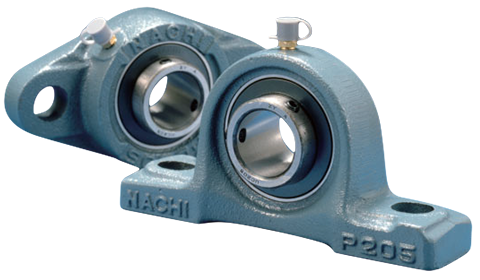In the field of industrial machinery and equipment, mounted bearings play a crucial role in ensuring the smooth and efficient operation of various mechanical systems. From conveyor belts and pumps to motors and fans, mounted bearings provide the necessary support and stability for rotating shafts. In this article, we will explore the fundamentals of mounted bearings, their types, applications, and the benefits they offer to industries across the globe.
What are Mounted Bearings
Mounted bearings, also known as bearing units, are self-contained units that consist of a bearing and a housing. The bearing, typically a ball or roller bearing, provides the rotating element, while the housing serves as a secure and stable support structure. Mounted bearings are designed to be easily mounted onto shafts, eliminating the need for complex and time-consuming assembly processes.
Types of Mounted Bearings
Pillow Block Bearings
Pillow block bearings, also called plummer blocks, are one of the most common types of mounted bearings. They consist of a spherical bearing and a cast iron or steel housing with a base mounting surface. Pillow block bearings are known for their versatility and ease of installation, making them suitable for various applications.
Flange Mounted Bearings
Flange-mounted bearings, as the name suggests, have a flange-shaped housing with mounting holes. These bearings are typically used when space is limited or when the shaft needs to be supported from a specific direction. Flange-mounted bearings are widely employed in conveyor systems, pumps, and small electric motors.
Take-Up Bearings
Take-up bearings are designed to accommodate the adjustment of the bearing’s position along the shaft. They are commonly used in applications where shaft misalignment or thermal expansion needs to be compensated for. Take-up bearings find applications in conveyor systems, packaging machinery, and material handling equipment.
Hanger Bearings
Hanger bearings, also known as suspended bearings, are used to support rotating shafts that are suspended or hung from a structure. They provide stability and help reduce vibrations in overhead conveyor systems and other suspended applications.
Insert Bearings
Insert bearings, also called cartridge bearings, have a cartridge-like housing that holds the bearing insert. These bearings offer easy installation and removal, making them suitable for applications where frequent bearing replacement is required. Cartridge bearings are commonly found in agricultural machinery, textile machines, and woodworking equipment.
Applications of Mounted Bearings
Mounted bearings find application in a wide range of industries and sectors. Some common areas where mounted bearings are utilized include:
Industrial Machinery
From conveyors and mixers to gearboxes and compressors, mounted bearings are extensively used in various industrial machinery applications. They provide reliable support and allow smooth rotational motion, contributing to efficient operation and productivity.
Agricultural Equipment
In the agricultural sector, mounted bearings are employed in machinery such as tractors, harvesters, and irrigation systems. They help withstand heavy loads, dust, and harsh outdoor conditions, ensuring reliable performance in demanding agricultural environments.
Automotive Industry
Mounted bearings play a vital role in automotive applications, including electric motors, wheel hubs, and transmission systems. They provide support and allow smooth rotation of various components, contributing to the overall performance and safety of vehicles.
HVAC Systems
Heating, ventilation, and air conditioning (HVAC) systems rely on mounted bearings for the efficient operation of fans, blowers, and pumps. These bearings help reduce friction and ensure smooth rotation, leading to improved energy efficiency and reduced maintenance needs.
Material Handling
Mounted bearings are widely utilized in material handling equipment, including conveyor systems, lifts, and cranes. They provide stable support for rotating shafts, enabling the efficient movement of goods in warehouses, distribution centers, and manufacturing facilities.
Advantages of Using Mounted Bearings
Using mounted bearings in industrial applications offers several advantages, including:
Increased Efficiency
Mounted bearings minimize friction and energy losses, allowing machinery to operate more efficiently. Reduced friction results in lower power consumption, improved productivity, and cost savings in the long run.
Reduced Downtime
Reliable mounted bearings help prevent unexpected failures and minimize unplanned downtime. Their robust construction and proper maintenance contribute to uninterrupted operations and increased equipment reliability.
Easy Replacement
Mounted bearings are designed for easy installation and replacement. This feature simplifies maintenance tasks and reduces the time required for repairs, minimizing the impact on production schedules.
Enhanced Durability
With proper selection and maintenance, mounted bearings can withstand demanding operating conditions, including heavy loads, high speeds, and harsh environments. Their durability and longevity contribute to long-term cost savings and improved equipment performance.
Installation and Maintenance of Mounted Bearings
Proper installation and regular maintenance are essential to maximize the performance and lifespan of mounted bearings. Here are some crucial steps to follow:
Proper Alignment and Mounting
During installation, ensure accurate shaft alignment and securely mount the bearing onto the shaft. Precise alignment reduces unnecessary stress and load on the bearing, allowing it to operate smoothly and efficiently.
Regular Lubrication
Implement a lubrication schedule to ensure that mounted bearings are properly lubricated. Regularly replenishing the lubricant helps reduce friction, dissipate heat, and prevent premature wear. Follow the manufacturer’s guidelines for lubrication intervals and use the recommended lubricant type.
Inspection and Replacement
Periodically inspect the mounted bearings for signs of wear, damage, or contamination. Any abnormalities, such as excessive noise, vibration, or overheating, should be promptly addressed. When necessary, replace worn or damaged bearings to prevent failures and minimize downtime.
In conclusion, mounted bearings are essential components in a wide range of industrial applications, providing stability, support, and efficient rotational motion. By understanding the types, installation procedures, and maintenance practices associated with mounted bearings, industries can ensure reliable and optimized machinery operation. Investing in high-quality mounted bearings and following recommended maintenance procedures is key to maximizing efficiency, reducing downtime, and achieving long-term cost savings.
Feel free to visit HVH Industrial Solutions if you have any questions, need more information, or are interested in purchasing a mounted bearing.
Also, you can check our Engineering Blog for more informative articles.

